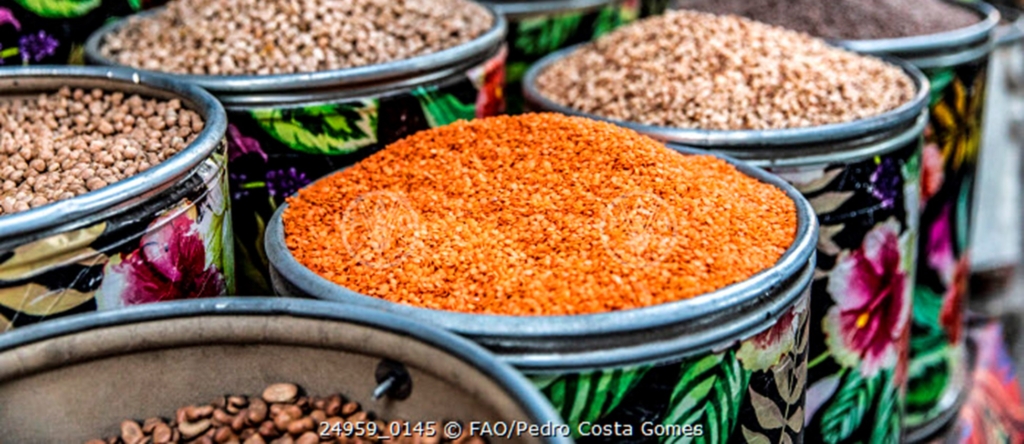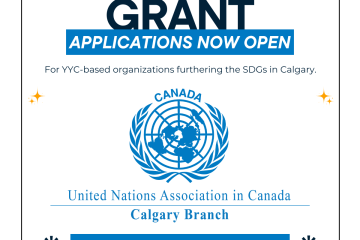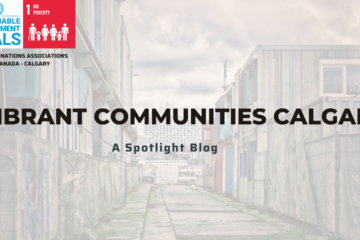
Varieties of pulses in Cairo, Egypt.
Photo Credit © FAO/Pedro Costa Gomes
Pulses for your Pulses
By: Angelina Patoka
Today we celebrate World Pulses Day (WPD) to underline the importance of pulses to food security, nutrition, and sustainability. It also serves to echo the Food and Agriculture Organization’s (FAO) previous work when it declared 2016 as the International Year of Pulses.
Pulses are recognized as a global food by the United Nations as these seeds bear an essential role in “the universal and transformative goals and targets of the United Nations’ 2030 Agenda for Sustainable Development.”
The FAO recognizes 11 types of pulses: dry beans, dry broad beans, dry peas, chickpeas, cowpeas, pigeon peas, lentils, Bambara beans, vetches, lupins and pulses nes (minor pulses that do not fit the other categories).
It is a food of paramount significance to the FAO as it seeks to address global challenges through its Strategic Framework, or the Four Betters, which includes Better Production, Better Nutrition, Better Environment, and Better Life. The organization states that pulses represent an efficient, inclusive, resilient and sustainable future for the world. One where pulses contribute to “creating economic, social and environmental opportunities for sustainable agrifood systems.”
What exactly does that mean?
UNAC – Calgary would like to emphasize that it acknowledges the biases, privileges, and otherwise misconceptions surrounding dietary choices in North America. At the same time, this makes the case for pulses much stronger.
Pulse crops produce a very low water footprint as a result of their adaptation to semi-arid conditions that makes them resistant to droughts. They use anywhere from a tenth to half as less water as other crops, meats included. In fact, the UN posits pulses as viable alternatives to meats due to their high nutritional values and agricultural efficiency.
This ought to be significant to Westerners since we consume more meat than any other region of the world while simultaneously we suffer from alarmingly high rates of cardiovascular diseases and fatalities that are frequently linked to poor nutrition and poor diets.
Pulse crops also help reduce greenhouse gases due to their ability to capture and store up to thirty per cent more carbon than other plants. In addition, legumes have root nodules that are produced by a specific soil bacteria group called rhizobia. These nodules fix nitrogen gas from the atmosphere and eventually turn it into a form of nitrogen that is used as a source of energy and nutrients. This symbiotic relationship enhances the soil microbiome (soil health) as once the legume perishes the nodules break down and typically infect another legume. This is also linked to their ecological resilience and their independence from synthetic fertilizers.
Given their ecological characteristics, pulses are economically appealing worldwide. They are inexpensive to grow and to store, which is arguably one of the reasons why it remains a staple food in numerous cultures around the world and how access to these crops continues to sustain large populations that do not have the privilege of maintaining Western-like agricultural sectors.
But is it really a privilege?
We have to recognize a few things outside of the white-centric worldview that pins food security as a humanitarian mission destined for postcolonial states classified as the ‘Global South.’ Not to mention, food insecurity was never completely eliminated in the West. Especially if one qualifies food security as access to highly nutritional and sustainable foods, and when one considers marginalized non-white populations, including those who reside in Canada’s Far North.
Food insecurity is a global existential threat as a result of climate change and Western agricultural systems in their present state are not necessarily the solution. The global scale of ecological destruction to accommodate agriculture has been a largely Western endeavour. Our systems are notoriously inefficient despite their economic and strategic importance.
The present situation in Calgary and Canada points to the need for greater agricultural vigilance. The pandemic revealed our dependence on very few food sources such as meats and wheat, which are less nutritional, far more environmentally taxing and less resilient than pulses.
Even more recently, the federal government and the provincial government of Alberta recognized the worries of Canadians regarding rising food prices and food supply shortages in supermarkets. These issues are reportedly caused by cross-border closures with the United States (which affects Canada despite its protectionist policies), labour shortages as a result of the pandemic, and drought conditions that affected agricultural focal points in the Prairies in the previous year.
Food supply issues are not new to Canada, where weather conditions have always been a challenge. Be it snowfall, ice, droughts or dust storms. While some politicians frame the topic as a matter of partisan discord, all these conditions reveal the core vulnerabilities ingrained in our system. The bigger picture demands greater concern with what is our food resources and how we source them in a sound and sustainable manner that suits the global realities of the twenty-first century.
Vaccination issues among truckers and other related labour shortages are worthy of discussion and serious attention, but if 70% of the food imports from the United States are distributed through trucks, where are the alternatives? Why are we so protective of inefficient systems that rely on inefficient resources, including fossil fuel, and clearly do not serve us?
I am not adequately equipped to form hypotheses nor proper answers to these questions in this short blog post, but I would like to state that there are local solutions to these universal problems. Long before the pandemic Calgarians applied themselves in multiple ways to approach food security.
Calgary launched its urban sustainability plan, imagineCALGARY, in 2006. It includes the Calgary Food Action Plan, also known as Calgary Eats!, and its goals of increasing sustainable farming in the city. Despite some setbacks, Mayor Jyoti Gondek recently advocated for the city-led efforts and pointed to future action concerning unused farmlands. One that could make use of fertility-induced plants like pulses, in my opinion.
Other local projects include Grow Calgary, which UNAC–Calgary collaborated with in the past, and more to the point the Alberta Pulse Growers (APG). An organization that represents over 6,500 pulse growers in the province, a significant growth compared to 5,000 Albertan pulse farmers in 2016. In addition, APG offers guidance and support to parties interested in starting to farm pulses.
There are options at an individual level as well! Calgarians of all walks of life engage in urban organic gardening and food dehydration. Again, all with accessible help and guidance online.
UNAC–Calgary hope this blog post got your pulses racing, in a good way! This is not intended to encourage anyone’s doomscrolling habits.
We are not cornered. We have choices. We have alternatives. We can make it happen. All it takes is… pulses? A double entendre that hopefully motivates you to put that green thumb to use one way or another. Happy World Pulses Day!
———————————————–
About Angelina:
Angelina Patoka is an University of Calgary undergraduate student in her fourth year of her combined political science and international relations degree. She is interested in all aspects of global governance, particularly security issues stemming from international conflicts and disagreements. Angelina began volunteering with UNAC Calgary in late 2020 and she is excited to share and discuss how Canada is affected by ever-evolving globalism.
————————————–
Sources and resources
- CBC.Ca(2021). CBC.Ca. https://www.cbc.ca/news/canada/manitoba/crop-yield-stats-canada-1.6284026Brehaut, L. (2021, December 9).
- Food to get a lot more expensive in Canada next year, thanks, in part, to inflation: report. National Post. https://nationalpost.com/news/canada/food-to-get-a-lot-more-expensive-in-canada-next-year-thanks-in-part-to-inflation-report
- Chacon, C. (2022, January 22). Grocery stores in Alberta continue to see more empty shelves as supply chain issues persist. Global News. https://globalnews.ca/news/8531312/grocery-stores-alberta-supply-chain-shelves/
- Deutsche Welle (www.dw.com). (n.d.). The power of pulses. DW.COM. https://www.dw.com/en/pulses-more-than-just-a-meat-alternative/a-56513673
- FAO Strategic Framework. (2022). FAO-StrategicFramework. https://www.fao.org/strategic-framework/en
- imagineCALGARY. (n.d.). Https://Www.Calgary.Ca. https://www.calgary.ca/pda/pd/office-of-sustainability/imaginecalgary.html
- Lack of action on supply chain will make âempty shelves the norm,â say Conservatives | RCI. (n.d.). Radio-Canada.Ca. https://ici.radio-canada.ca/rci/en/news/1856833/lack-of-action-on-supply-chain-will-make-empty-shelves-the-norm-say-conservatives
- Stober, E. (2022, January 26). Canadians may see less food in grocery stores, but experts say no need to panic. Global News. https://globalnews.ca/news/8532207/canada-grocery-stores-food-supply-prices/
- United Nations. (2022). World Pulses Day. https://www.un.org/en/observances/world-pulses-day
- U.S. defeats Canada in first dispute under new North American trade pact | CBC News. (2022). CBC News. https://www.cbc.ca/news/world/dairy-dispute-panel
- What are Pulses? (2022). Pulses.Org. https://pulses.org/what-are-pulses
- Why Calgary’s food plan is now an economic booster, not a plan to feed its people. (2022). CBC News. https://www.cbc.ca/news/canada/calgary/chickens-calgary-indoor-farms-food-cost-climate
- World Pulses Day. (2022). Food and Agriculture Organization of the United Nations. https://www.fao.org/world-pulses-day/en/World Pulses Day – A designated United Nations global event to recongnize the importance of pulses as a global food.
- (2022). World Pulses Day. https://worldpulsesday.org


